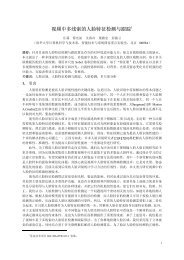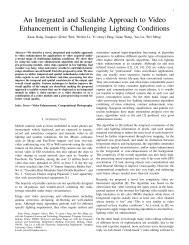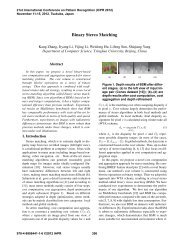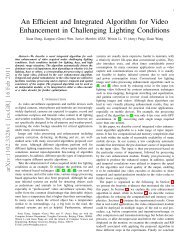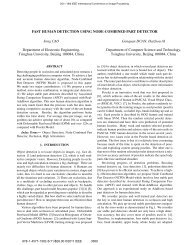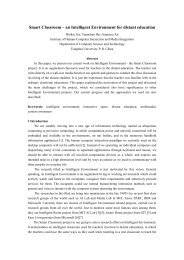Human Detection in Video over Large Viewpoint Changes
Human Detection in Video over Large Viewpoint Changes
Human Detection in Video over Large Viewpoint Changes
Create successful ePaper yourself
Turn your PDF publications into a flip-book with our unique Google optimized e-Paper software.
1252 G. Duan, H. Ai, and S. Lao<br />
memory requirements impractical. With the distance of two granules def<strong>in</strong>ed <strong>in</strong><br />
Sec. 3.1, two effective constra<strong>in</strong>ts are <strong>in</strong>troduced <strong>in</strong>to I 2 CF : 1)Motivated by [5],<br />
the first pair of granules <strong>in</strong> I 2 CF is constra<strong>in</strong>ed as d(g i 1, g j 1 ) ≤ T 1. 2) Consider<strong>in</strong>g<br />
of the consistency <strong>in</strong> one frame or two near video frames, we constra<strong>in</strong> that the<br />
second pair of granules <strong>in</strong> I 2 CF is <strong>in</strong> the neighborhood of the first pair as shown<br />
<strong>in</strong> Fig. 2 (d):<br />
d(g i 1, g i 2) ≤ T 2 , d(g j 1 , gj 2 ) ≤ T 2. (7)<br />
We set T 1 = 8, T 2 = 4 <strong>in</strong> our experiments.<br />
Table 1: Learn<strong>in</strong>g algorithm of I 2 CF .<br />
Input: Sample set S = {(x i , y i )|1 ≤ i ≤ m} where y i = ±1.<br />
Initialize: Cell space (CS) with all possible cells and empty I 2 CF .<br />
Output: The learned I 2 CF .<br />
Loop:<br />
– Learn the first pair of granules as [5]. Denote the best f pairs as a set F .<br />
– Construct a new set CS’: In each cell of CS’, the first pair of granules is from F , the<br />
second pair of granules is generated by Eq. 7 and its mode is A-mode, D-mode or C-mode.<br />
Calculate Z value of I 2 CF by add<strong>in</strong>g each cell <strong>in</strong> CS’.<br />
– Select the cell with the lowest Z value, denoted as c ∗ . Add c ∗ to I 2 CF .<br />
– Ref<strong>in</strong>e I 2 CF by replac<strong>in</strong>g one or two granules <strong>in</strong> it without chang<strong>in</strong>g the mode.<br />
Heuristically learn<strong>in</strong>g I 2 CF starts with an empty I 2 CF . Each time select<br />
the most discrim<strong>in</strong>ative cell and add it to I 2 CF . The discrim<strong>in</strong>ability of a weak<br />
feature is measured by Z value, which reflects the classification power of the<br />
weak classifier as [17]:<br />
Z = 2 ∑ √<br />
W+W j −, j (8)<br />
j<br />
where W j + is the weight of positive samples that fall <strong>in</strong>to the j th b<strong>in</strong> while W j −<br />
is that of negatives. The less Z value is, the more discrim<strong>in</strong>ative a weak feature<br />
is. The learn<strong>in</strong>g algorithm of I 2 CF is summarized <strong>in</strong> Table 1. (See more details<br />
<strong>in</strong> [5] [16].)<br />
4 EMC-Boost<br />
We propose the EMC-Boost to co-cluster the sample space and discrim<strong>in</strong>ative<br />
features automatically. A perceptual cluster<strong>in</strong>g problem is shown <strong>in</strong> Fig. 3 (a)-<br />
(c). EMC-Boost consists of three components, Cascade Component (CC), Mixed<br />
Component (MC) and Separated Component (SC). The three components are<br />
comb<strong>in</strong>ed to become EMC-Boost. In fact, SC is similar to MC-Boost [13], which<br />
is the reason that our boost<strong>in</strong>g algorithm is named as EMC-Boost. In the follow<strong>in</strong>g<br />
descriptions, we formulate the three components explicitly first, and then<br />
demonstrate the learn<strong>in</strong>g algorithms, and summarize EMC-Boost at the end of<br />
this section.



